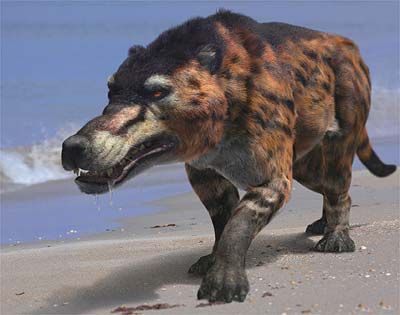 Awwwww..don't you just want to pet him? souce:http://en.wikipedia.org/wiki/Andrewsarchus_mongoliensis visit it..its a really good website... hope u enjoyed it!
Awwwww..don't you just want to pet him? souce:http://en.wikipedia.org/wiki/Andrewsarchus_mongoliensis visit it..its a really good website... hope u enjoyed it! new emblem..and its history
by Deanna_T on Comments
Well y'all, the beast you see to the right is actully a very, very, very x5, distant relative of the modern whale. Yes, MODERN whale. What is this amazing creatures name? Andrewsarchus. Yes, the Andrewsarchus. A wolf like animal about 12 ft at the shoulder, with hoofs & lived in Mongolia. Wait..theres more. :) Andrewsarchus Andrewsarchus mongoliensis was the largest member of the mesonychids, a group of extinct prehistoric mammals. The mesonychids were the only known group of ungulates to become carnivorous, and looked rather like wolves with hooves. Andrewsarchus ("Andrews's ruler") was named for the famous explorer and fossil hunter Roy Chapman Andrews, who led the expedition on which it was discovered. Andrewsarchus is known only from an enormous skull and pieces of bone, but the skull's similiarity to that of smaller mesonychids suggests that Andrewsarchus had the same wolf-like body on a larger scale. It was probably about 4-5 metres long, standing nearly 2 metres at the shoulder, making it the largest terrestrial carnivorous mammal that has ever existed. Whale part: The fossils of the group most closely related to Andrewsarchus are usually found singly, and around water, and this attachment to water became greatly exaggerated in one group of its relatives which eventually became entirely marine - the whales. It is thought that they were solitary animals. Andrewsarchus lived 60-32 million years ago, in the Eocene era. Since Andrewsarchus evolved not long after the Cretaceous-Tertiary Extinction Event, it is somewhat of a mystery as to what Andrewsarchus ate. It obviously ate large animals, though the fossil record of potential prey from the Paleocene and early Eocene is scant. In the period after the non-avian dinosaurs went extinct there were at first no large land mammals, no whales, and no dedicated dry-land predators of any size. But the extinction opened up ecological niches and caused a burst of evolution to occur. Very soon large land mammals evolved, carnivorous birds such as Gastornis/Diatryma, and even crocodiles adapted for a running existence evolved. These all may have been potential prey. To judge from its immense jaws, and the coastal location of the fossils, Andrewsarchus may have fed on beached primitive whales, shellfish and hard-shelled turtles at various periods during its existence. Also toward the end of the Eocene very large mammals had evolved in the region of Central Asia. Andrewsarchus possessed some of the strongest jaws that ever evolved in a land animal, able to bite through large bones if needed. However, most very large specialized land predators in the history of the Earth have required the availbility of similarly large prey, making them vulnerable as individuals to environmental change and starvation. This last process has caused many such animals to be eventually replaced by other forms that had a less restrictive diet. Giant specialized land predators would then evolve all over again, eventually be replaced, and the process would repeat itself. Andrewsarchus apparently had a successful run as a species, but eventually became extinct, almost certainly because of its dietary requirements. Andrewsarchus also, like other early Cenozoic predators, faced increasing competition from the Miacids and their decendants, modern carnivorous mammals (Carnivora). Andrewsarchus and related predatory mammals lived in the Northern Hemisphere alongside with the creodonts and earliest modern carnivores, also with giant terrestrial predatory birds such as Diatryma. Isolated Southern Hemisphere areas such as Australia and South America evolved their own totally separate lines of predatory land animals, including lines of flightless giant birds and marsupials such as the Australian Thylacoleo, a "marsupial lion," by the process of convergent evolution.  Awwwww..don't you just want to pet him? souce:http://en.wikipedia.org/wiki/Andrewsarchus_mongoliensis visit it..its a really good website... hope u enjoyed it!
Awwwww..don't you just want to pet him? souce:http://en.wikipedia.org/wiki/Andrewsarchus_mongoliensis visit it..its a really good website... hope u enjoyed it!
 Awwwww..don't you just want to pet him? souce:http://en.wikipedia.org/wiki/Andrewsarchus_mongoliensis visit it..its a really good website... hope u enjoyed it!
Awwwww..don't you just want to pet him? souce:http://en.wikipedia.org/wiki/Andrewsarchus_mongoliensis visit it..its a really good website... hope u enjoyed it!
Log in to comment